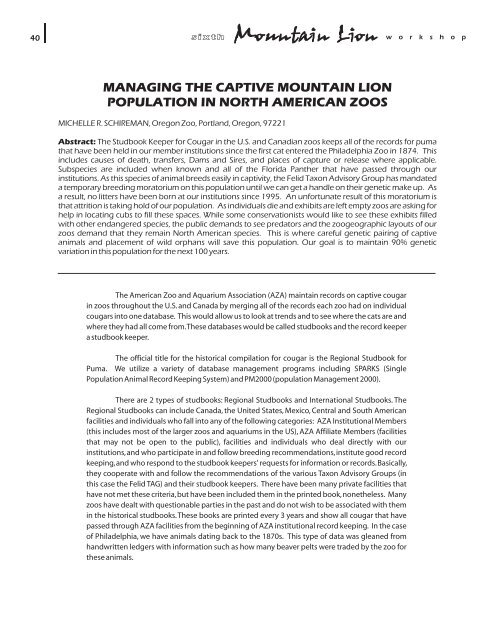PWD BK W7000-893 Proceedings.CDR - Mountain Lion Foundation
PWD BK W7000-893 Proceedings.CDR - Mountain Lion Foundation
PWD BK W7000-893 Proceedings.CDR - Mountain Lion Foundation
Create successful ePaper yourself
Turn your PDF publications into a flip-book with our unique Google optimized e-Paper software.
40<br />
MANAGING THE CAPTIVE MOUNTAIN LION<br />
POPULATION IN NORTH AMERICAN ZOOS<br />
MICHELLE R. SCHIREMAN, Oregon Zoo, Portland, Oregon, 97221<br />
sixth <strong>Mountain</strong> <strong>Lion</strong> w o r k s h o p<br />
Abstract: The Studbook Keeper for Cougar in the U.S. and Canadian zoos keeps all of the records for puma<br />
that have been held in our member institutions since the first cat entered the Philadelphia Zoo in 1874. This<br />
includes causes of death, transfers, Dams and Sires, and places of capture or release where applicable.<br />
Subspecies are included when known and all of the Florida Panther that have passed through our<br />
institutions. As this species of animal breeds easily in captivity, the Felid Taxon Advisory Group has mandated<br />
a temporary breeding moratorium on this population until we can get a handle on their genetic make up. As<br />
a result, no litters have been born at our institutions since 1995. An unfortunate result of this moratorium is<br />
that attrition is taking hold of our population. As individuals die and exhibits are left empty zoos are asking for<br />
help in locating cubs to fill these spaces. While some conservationists would like to see these exhibits filled<br />
with other endangered species, the public demands to see predators and the zoogeographic layouts of our<br />
zoos demand that they remain North American species. This is where careful genetic pairing of captive<br />
animals and placement of wild orphans will save this population. Our goal is to maintain 90% genetic<br />
variation in this population for the next 100 years.<br />
The American Zoo and Aquarium Association (AZA) maintain records on captive cougar<br />
in zoos throughout the U.S. and Canada by merging all of the records each zoo had on individual<br />
cougars into one database. This would allow us to look at trends and to see where the cats are and<br />
where they had all come from.These databases would be called studbooks and the record keeper<br />
a studbook keeper.<br />
The official title for the historical compilation for cougar is the Regional Studbook for<br />
Puma. We utilize a variety of database management programs including SPARKS (Single<br />
Population Animal Record Keeping System) and PM2000 (population Management 2000).<br />
There are 2 types of studbooks: Regional Studbooks and International Studbooks. The<br />
Regional Studbooks can include Canada, the United States, Mexico, Central and South American<br />
facilities and individuals who fall into any of the following categories: AZA Institutional Members<br />
(this includes most of the larger zoos and aquariums in the US), AZA Affiliate Members (facilities<br />
that may not be open to the public), facilities and individuals who deal directly with our<br />
institutions,and who participate in and follow breeding recommendations,institute good record<br />
keeping,and who respond to the studbook keepers' requests for information or records.Basically,<br />
they cooperate with and follow the recommendations of the various Taxon Advisory Groups (in<br />
this case the Felid TAG) and their studbook keepers. There have been many private facilities that<br />
have not met these criteria,but have been included them in the printed book,nonetheless. Many<br />
zoos have dealt with questionable parties in the past and do not wish to be associated with them<br />
in the historical studbooks.These books are printed every 3 years and show all cougar that have<br />
passed through AZA facilities from the beginning of AZA institutional record keeping. In the case<br />
of Philadelphia, we have animals dating back to the 1870s. This type of data was gleaned from<br />
handwritten ledgers with information such as how many beaver pelts were traded by the zoo for<br />
these animals.
















